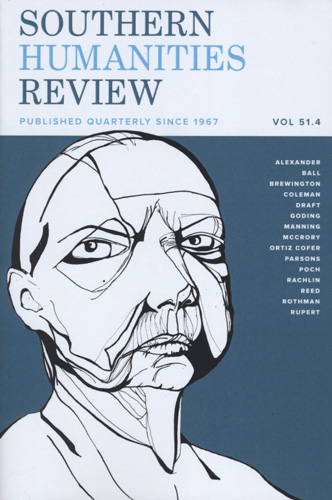Southern Humanities Review – 2018
The latest issue of Southern Humanities Review features a set of four flash fictions by Judith Ortiz Cofer, a good sampling of the rest of the writing inside the issue: “My Mother Comes Back from the Dead,” “Eleven,” “Thirteen,” and “Sen-Sen.” Themes of family, self, and gender appear repeatedly in these four, posthumously published pieces, bound together by a common voice. I imagined the same narrator speaking throughout the pieces.
The latest issue of Southern Humanities Review features a set of four flash fictions by Judith Ortiz Cofer, a good sampling of the rest of the writing inside the issue: “My Mother Comes Back from the Dead,” “Eleven,” “Thirteen,” and “Sen-Sen.” Themes of family, self, and gender appear repeatedly in these four, posthumously published pieces, bound together by a common voice. I imagined the same narrator speaking throughout the pieces.
“My Mother Comes Back from the Dead” and “Sen-Sen” bookend the set, similar in the ways parents return to loved ones after their deaths. In the former, the narrator’s mother appears “as a sigh, as a yearning. I remember her touch on my forehead, a fever.” She finds herself haunted by “hunger for something I can’t name,” her mother’s presence a worry that gnaws at her in the night, the repetition of phrases reflecting this feeling of desperation.
The ghost of the narrator’s father is brought to light in “Sen-Sen” as he comes to her mother in the scent of the titular breath freshener he once used. We often hear of people holding onto belongings of loved ones after a death or a break-up, their scent bringing comfort to those left behind. But in this piece, the scent reminds the narrator and her mother of the nights when he’d stay out late with friends and—as her mother suspects—other women. The scent comes with a slew of negative feelings and memories wrapped up with marriage and expected gender roles within marriage. The mother rallies against these expectations, “angry that she had sweated over the ironing board, that she had outfitted him for a party she could not attend.” In fact, when the ghost of her father visits, her: “mother hurries to switch the fan on. [ . . . ] By the deep breath she takes, I know that she has taken him in, and through her long exhale, I hear her letting him go, inevitably, into the night again. Sen-Sen.” I enjoyed seeing a different side to this posthumous reminiscing than what is normally spoon-fed readers.
The two bookended pieces “Eleven” and “Thirteen” carry on the exploration of gender expectations, this time focusing on the ways in which young girls are saddled with the burden of gender roles reflected in the ways they dress or groom their body hair. In “Eleven,” Cofer’s narrator recounts her eleventh birthday in which she dressed up in the too-big clothes and makeup of her older family members, her family members all acting negatively in response. But the music, her innocence, and the high of a day being all about her makes her immune to their frowns and laughter.
“Thirteen” focuses on bodies, on curvy hips and body hair. The narrator’s neighbor isn’t allowed to shave for religious reasons, “the hair on her shapely legs curled beneath the pressure of her nylons.” While others judge or make fun, her mother “always had a tender smile and a compliment” for the neighbor girl. The piece ends reflecting on her mother saying, “‘Tu sabes, a woman’s strength is in her hair,” causing the reader to consider the ways in which hair removal products are pushed toward women and the amount of time and effort that goes into the process. Why put ourselves through the effort and financial burden as we spend time hating our body hair when we typically value and equate beauty and femininity with hair that sprouts from our heads? Why the double standard when it comes to other parts of our body?
While this is just a small sample of her writing, Cofer’s body of work widely spans across poetry, fiction, nonfiction, and children’s literature. The pieces in this issue of Southern Humanities Review are a great introduction to her work, inviting readers to explore more of what Cofer’s writing has to offer.
[www.southernhumanitiesreview.com]





